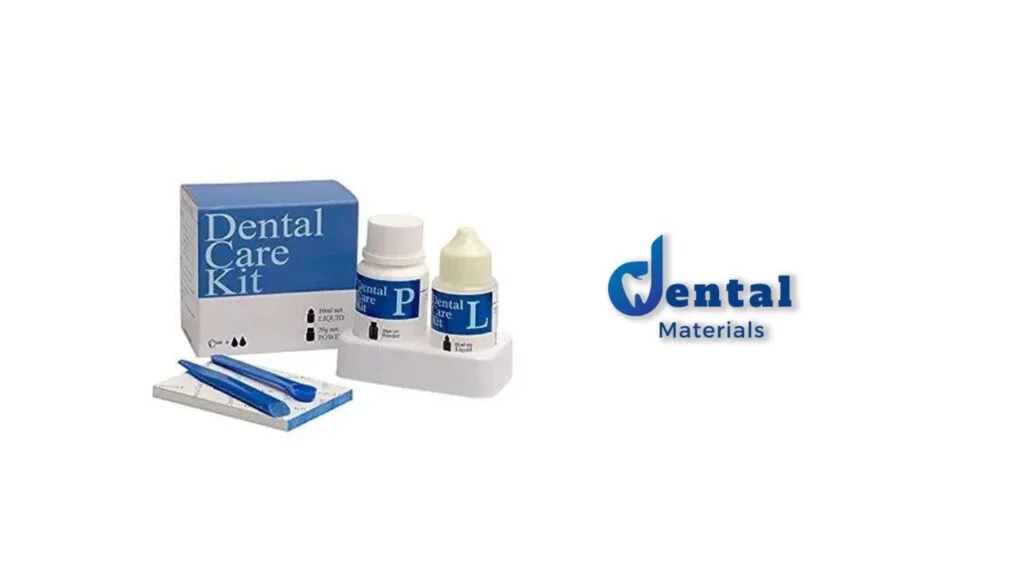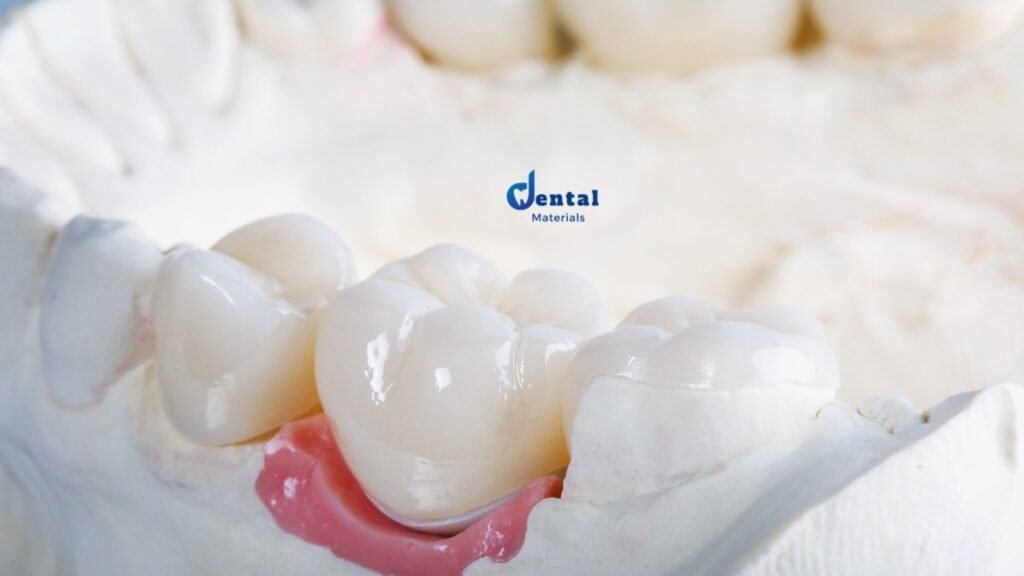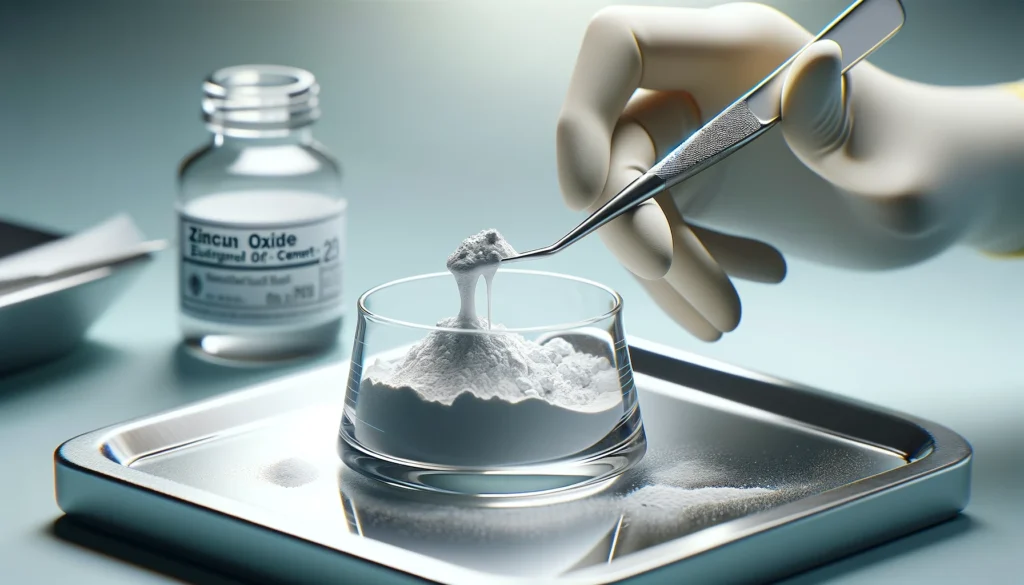Zinc oxide eugenol (ZOE) is a commonly used dental material that combines zinc oxide, a white powder, with eugenol, a liquid derived from certain plants. When mixed, these components form a paste with various beneficial properties for dental applications.
ZOE stands out for its therapeutic effects on dental tissues and is frequently employed as a temporary filling material. Beyond its antimicrobial properties, which aid in preventing infections, ZOE exhibits radiopacity, making it visible on dental X-rays. This radiopacity is crucial for dental professionals to monitor the treated area and assess the effectiveness of the dental work.

Additionally, the material is malleable, allowing for easy shaping to cover and safeguard teeth after various dental procedures. Due to its versatility and comprehensive set of properties, ZOE plays a vital role in dentistry for temporary dental applications and other instances where a protective, antimicrobial, and radiopaque material is required.
It can be used as a liner under restorations, a cement for fixed prosthesis or as a root canal sealer.
Composition
- Zinc Oxide: This is the primary ingredient in the powder form.
- Eugenol: It is a liquid, which when mixed with the zinc oxide powder, forms the ZOE cement. Eugenol is derived from the oil of cloves and possesses several beneficial properties, including analgesic and antiseptic effects.
Advantages
- Sedative Effect: One of the most prominent benefits of ZOE is its mild sedative effect on the dental pulp. This makes it particularly useful in situations where the pulp might be slightly irritated.
- Antibacterial Properties: Eugenol, a component of ZOE, possesses antiseptic properties, giving ZOE its antibacterial characteristics.
- Biocompatibility: ZOE is well-tolerated by the oral tissues, resulting in fewer allergic reactions or irritations compared to some other materials.
- Thermal Insulation: ZOE provides a good thermal barrier, protecting the tooth pulp from temperature changes, especially in restorations close to the pulp.
- Easy to Manipulate: The consistency and setting time of ZOE can be easily controlled, making it user-friendly for dental practitioners.
- Low Cost: Compared to other dental materials, ZOE is relatively inexpensive, making it a cost-effective choice for certain applications.
- Ease of Removal: When used as a temporary measure, ZOE is easy to remove without causing damage to the underlying tooth structure.
- Adhesion: It adheres well to the tooth structure, providing a reasonable seal, which is especially beneficial in endodontic applications.
- Radiopacity: ZOE is radiopaque, meaning it can be visualized on dental radiographs, which is useful for assessment and quality checks.
- Versatility: Its diverse applications range from serving as a temporary filling material and a liner/base under restorations to being used as a temporary cement for crowns and as a root canal sealer.
Limitations
While Zinc Oxide Eugenol (ZOE) cement offers multiple advantages in dentistry, it also comes with several limitations:
- Strength and Durability: ZOE is not as strong or durable as many other dental cements. This makes it unsuitable for permanent restorations in areas with heavy masticatory forces.
- Inhibition of Resin Setting: Eugenol, a component of ZOE, can inhibit the polymerization of resin-based dental materials. Therefore, ZOE is not recommended under composite restorations unless it’s a modified type that is eugenol-free.
- Discoloration: Over time, ZOE can discolor, especially if exposed in the oral environment.
- Solubility: ZOE has a higher solubility compared to other dental cements, which means it can dissolve over time when in contact with oral fluids. This can compromise its efficacy and longevity, especially in long-term applications.
- Brittleness: ZOE can be brittle and may fracture under pressure.
- Poor Resistance to Erosion: In areas exposed to acid or abrasive forces, ZOE can wear down relatively quickly.
- Longer Setting Time: Compared to some modern dental materials, ZOE can have a longer setting time, which might not be ideal in all clinical situations.
- Not Aesthetic: ZOE is not tooth-colored and is not suitable for visible or aesthetic areas.
- Limited Adhesion: While it adheres reasonably to the tooth structure, its bond strength is inferior to many modern adhesive systems.
- Potential Allergy: Rarely, some patients might exhibit an allergic response to eugenol or other components of ZOE.
Given these limitations, it’s essential for dental practitioners to weigh the benefits against the drawbacks and choose ZOE where its specific advantages can be best utilized, and its limitations are least problematic.
Mixing
When discussing the mixing of Zinc Oxide Eugenol (ZOE) cement, the process refers to combining the powdered zinc oxide with the eugenol liquid to form a material with a paste-like consistency that can be applied in dental treatments. Here’s a basic outline of the mixing process:
- Proportions: Typically, ZOE is provided in a powder and liquid form. The manufacturer’s instructions will detail the exact proportions for mixing, which usually involves a specific amount of powder to a specific number of drops of eugenol.
- Dispensing: Both the powder and liquid are dispensed onto a mixing pad or glass slab. The powder is usually placed in small increments.
- Mixing Technique: Using a spatula, the powder is incorporated into the liquid in small increments until the desired consistency is achieved. The mix should be smooth and free from lumps.
- Consistency: Depending on the intended use, the consistency might vary. For example:
- For a base or liner, a thinner consistency might be preferred.
- For a temporary filling or cementation, a thicker consistency is required.
- Working Time: The working time (the period during which the mixed cement remains malleable and usable) of ZOE can be short. It’s essential to apply it in the required setting promptly after mixing.
- Setting Time: Once mixed and applied, the ZOE will set in the mouth, usually within a few minutes. The setting time can vary based on the brand and specific formulation.
- Temperature: Mixing on a cool glass slab can extend the working time slightly, as the setting reaction is exothermic (it releases heat).
- Mixing Other Varieties: There are modified types of ZOE, like reinforced ZOE, which contain additional materials to improve certain properties. These might have slightly different mixing protocols, so always refer to the manufacturer’s instructions.
Proper mixing is crucial to ensure the optimal properties of the ZOE cement are achieved. Additionally, it’s always essential to follow manufacturer instructions to get the desired properties from the material. Improper mixing can lead to reduced setting times, compromised strength, and other undesired outcomes.




